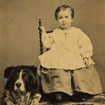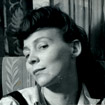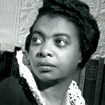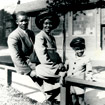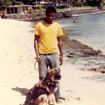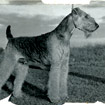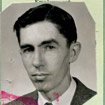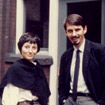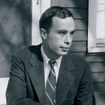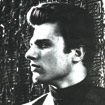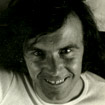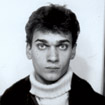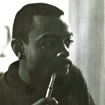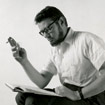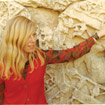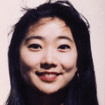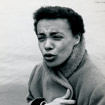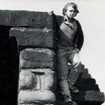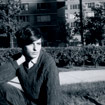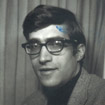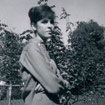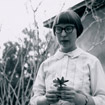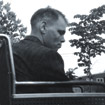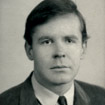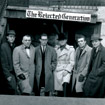Poet Photos Portfolio
Unseen treasures from the archives of the magazine.
BY The Editors

From its earliest days, the editors have always requested that each poet published in our pages supply an author photo of some kind, a practice that continues to the present day. Rummaging through the many thousands of photos on file in the office, it occurred to us that this collection constitutes something of a family album.
Harriet Monroe founded Poetry in 1912 and edited the magazine for twenty-four years.
The picture of a pregnant Marie Ponsot was taken in Paris, where she had met and married a painter who was a student of Fernand Léger. The couple had six children before they divorced. Marie raised them herself, writing all the while.
The photo of Ruth Stone was taken by her husband Walter, shortly before he committed suicide. She, too, was a poet who wrote while raising her children alone. Having published thirteen books of poems during her long lifetime, she characterized her work as “love poems, all written to a dead man.”
Margaret Danner was a Chicago poet who became an editorial assistant at Poetry in 1951, then associate editor in 1956. Devoted to what she called the “social conscious,” she later founded Boone House in Detroit to serve as a cultural center for black writers, musicians, and artists.
Gwendolyn Brooks needs little introduction to readers of Poetry; she is shown here with her family.
Chicago poet Calvin Forbes is shown here as a young man in Honolulu in 1969, living that year, he tells us, “more or less hand to mouth.” He’s posing with his dog, Aengus, who was named after Yeats’s poem, “Song of the Wandering Aengus,” during what Forbes calls “my Yeats period, which I never quite outgrew.”
Yvor Winters sent in a photo of his Airedale, Buckthorn Sally, who was, he claimed, a “finer work of art” than most of the poems we publish. In a letter reproduced in our July/August 2009 issue, Winters noted that he was an “an Airedale fancier. In my capacity as a teacher, I correspond, I suppose, to a professional handler at a dog show.”
The Scottish poet and physician Gael Turnbull, who started the famed Migrant Press to publish modernist poetry, supplied his passport photo, one of many poets who seems not to have had author photos on hand.
Our readers will recognize Robert Creeley, shown here with his first wife, Bobbie Louise Hawkings, but Landis Everson was a more enigmatic figure. Part of the Berkeley Renaissance of the fifties with such better known poets as Robert Duncan and Jack Spicer, he dropped out of poetry for a while, but was rediscovered in recent years. His first collection of poems, Everything Preserved: Poems 1955–2005, won the Emily Dickinson First Book Award from the Poetry Foundation. It’s said that though being something of a loner, he was friends with the likes of Farley Granger and Eva Marie Saint.
Readers might not recognize him from his author photo, but the poet, photographer, and filmmaker Gerard Malanga continues to be known for his own creative work as well as for his epochal collaborations with Andy Warhol.
The Slovenian poet Tomaž Šalamun, championed by Robert Hass and others, has gained a wide readership in recent years; but the photo here was taken early in his career, not long after being jailed on political charges and publishing his first book in a samizdat edition.
Michael Hofmann is seen some thirty years ago, wearing a jacket that had belonged to his father, the writer Gert Hofmann, and posing in a photo booth, he tells us, “in Germany (probably) or some railway station in England.”
LeRoi Jones is shown here in 1962, three years before the assassination of Malcolm X led him to change his life and, eventually, his name. Paul Blackburn is also shown here in the early sixties, some time after befriending Ezra Pound, through whom he came into contact with Robert Creeley, and eventually Charles Olson, Denise Levertov, and Cid Corman, all fellow Poetry contributors.
Most readers know Erica Jong as the author of Fear of Flying and other novels, but she has published over a half-dozen books of poetry. When Jong first appeared in Poetry, Suji Kwock Kim, shown in the next photo, was only two years old.
Sharon Bourke’s photo accompanied her first appearance in the magazine in 1961; though she didn’t appear in our pages after 1963, she has gone on to become a successful visual artist.
Tom Pickard, shown here atop a medieval wall near the Morden Tower in Newcastle upon Tyne, was first published in Poetry in 1965 (the same year he invited Basil Bunting to give his first public reading of his newly written poem Briggflatts, which was published in Poetry). Tom won the magazine’s Bess Hokin Prize in 2011.
Lewis Warsh is shown situated in a less ancient setting—New York City—in this photo taken by fellow poet Anne Waldman.
We’re not sure where this photo of a young Robert Pinsky was taken, but a contemporaneous snapshot of Louise Glück was almost certainly made on the East Coast, where she has spent a great deal of her life.
From the trees in the background we move on to Diane Wakoski, holding a single flower, and to wheelchair-bound Larry Eigner. Larry Eigner, a long-time contributor, was born, as he put it, “palsied from hard birth” and composed his poems on a 1940 Royal manual typewriter, using only his right index finger and thumb.
Ronald Johnson, shown here in coat and tie, became an influential concrete poet, famous for his erasure poem, RADI OS, composed by blocking out words in his copy of Paradise Lost. He also composed a long poem, ARK, twenty years in the making—and a number of highly-regarded cookbooks.
Last but not least are some gentlemen from Milwaukee who called themselves “The Rejected Generation,” circa 1960, perhaps along the lines of the Beats. We don’t know much about them, but the picture includes Ray Peekner (aka Ray Puechner), John Schmidt, and Jay Robert Nash (who went on to write Dillinger: Dead or Alive?). Their poems were never, as far as we can tell, published in Poetry, but they’ve made it into the magazine anyway in the end.
The editorial staff of the Poetry Foundation. See the Poetry Foundation staff list and editorial team masthead.



